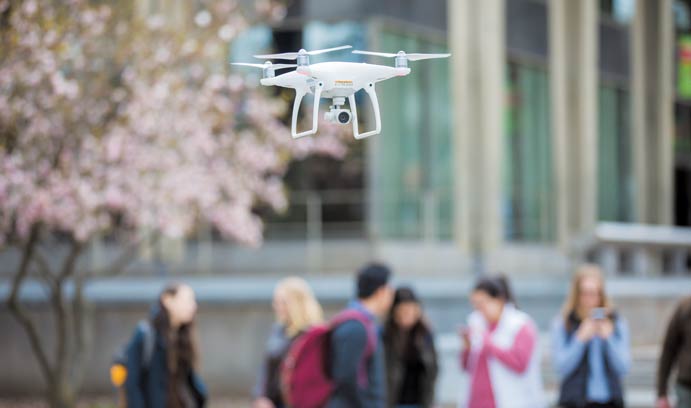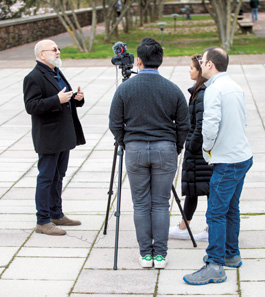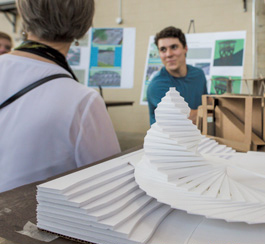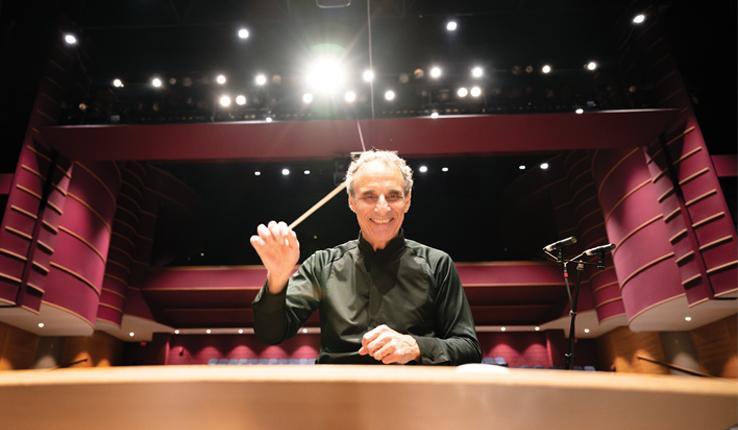A Footbridge, a New Way of Storytelling

Lehigh journalism students use a drone to capture footage. Photo: Christa Neu
A whirring, white drone hovered over Bethlehem City Hall plaza on a gray Monday in April, its low buzz audible as Professor Anthony Viscardi explained the appeal of a proposed pedestrian bridge linking the city’s north and south sides.
Students in Viscardi’s art, architecture and design course had been tasked with conceptualizing the bridge’s design, as well as the areas on either side of the bridge that would receive those walking or biking across the expanse.
Now, Lehigh journalism students were testing out new ways to inform people about the bridge project—with drone video footage that would help tell the story and provide a bird’s eye view of the area.
With students and professors from two distinct classes coming together on a spring day for the sake of learning, the pairing demonstrated the interdisciplinary collaborations at Lehigh that often result in innovative projects. Staff from Library & Technology Services, who assisted with piloting the drone, facilitated.
For the journalism students, “This is just a small taste of what you can do with drones,” says Jeremy Littau, associate professor of journalism. Littau co-teaches his multimedia storytelling course with Matt Veto, professor of practice in the department of journalism and communications and faculty adviser to The Brown and White. “We want them to see how drones can be used [in news gathering],” Littau says. “Then we want them to dream bigger.”
Veto says the drone usage, along with instruction in 360-video and chatbots (applications that allow users to have humanlike conversations with an artificially intelligent program), augments traditional news-gathering techniques and provides students with a glimpse into the future of journalism. “We want to give them new tools,” Veto says.
Meanwhile, Viscardi created his Building Community Bridges course in response to community efforts to build a pedestrian bridge over the Lehigh River in Bethlehem. Viscardi, who has been involved in those efforts with the Sierra Club and the South Side Initiative, says a pedestrian bridge would not only link the city’s north and south sides but also provide safe passage for walkers and bicyclists across the river and help revitalize parts of the city that need it.
“The bridge [project] is an experiment in getting students to learn how to collaborate,” Viscardi says. For city officials and residents, “I want my students to not so much show them the most practical, efficient bridge to get across the river—because I feel academia is a time to explore ideas—[but] to generate ideas that go beyond just, how do you get from A to B quickly?
“How do we talk about this notion of moving from one side to the other?” Viscardi asks. “What does it mean when a north and a south no longer see themselves as the north and the south and as a unified city? What is the role of Sand Island, which is in a way almost like a zipper that pulls the two sides together because it doesn’t belong to one side or the other?”
When Viscardi shows the student-generated ideas to the community, he says, there are always a few people who think, “This is crazy. We can’t do that.” But someone also will say, “Oh, I didn’t think of that.”
On this afternoon, Viscardi stands in the plaza, answering student questions about the bridge project. Melissa McCloy ’20, a journalism and graphic design double major, is among those who take a turn in gathering information. It’s her first time using a drone to help tell a story. “I’m interested to see how it turns out,” she says. “It’s fun.”
Nearby is Hank Portney ’21, who is pursuing degrees in mechanical engineering and product design. Working with architecture student Colin Fish ’19, he imagines an interactive, flexible bridge with walls that react to the people who cross it. Portney likens the design to a forest with trees that move with the wind and shelter people from the sun. “This is what could be,” he says.
As a next step, Viscardi says, community groups plan to raise money for a feasibility study.
The journalism students' final projects included drone footage.
Here are some of their projects:
Posted on:






